


Temple of Pujiu-si was situated at the ancient city of Puzhou in Yongji County of Yuncheng city in south west of Shanxi Province. It is the most interesting attraction among many historical sites here as it is not only being a monastery but contradictorily also was the place where the romance of Chinese Romeo and Juliet in the novel of The West Chamber (西厢记)took place. Nobody can trace out the exact history and when was it first built. Basing on the records of old literature and also some artifacts unearthed from the area, it was estimated to be most probably built in early Sui Dynasty (589-618). Majority of the structures at the temple complex had no more been existing after year 1949, except the Pagoda, Stone lion sculpture and Buddhist Idol Cave. The present site was restored and repaired in year 1986, after receiving millions of fund supported from Government.



Pujiu-si Temple site basically has two sections. The Grand Hall, Relic Pagoda, Bell Tower, several Bodhisattva and Arahats shrine halls, Buddhist Idol Caves and Sutra Pavilion are clustered on left and right axes by the central. While the Tang styled garden is at the back yard of the complex.



The Drum Chamber and the Winding Corridor at The Pagoda Court. The love story of Zhangsheng and Yingying were written and illustrated along the Winding Corridor. Ironically, Pujiu-si is in fame as a love land more than a monastery.




The Love legend of West Chamber: During ancient time, people studied in order to go for politics. Zhangsheng was a student who left his hometown for the capital upon his study. On the way, he stopped to stay at Pujiu-si which was a monastery as well as a haven for travelers. He caught sight of Yingying, the daughter of a chief minister who was also living here, and deeply fell in love with her and asked for her hand. Yingying's mother objected as he had no status and not able to provide her daughter a good living. With the assistance of Yingying's maid, Hongniang, the couple continued their love affair. The Monastery and Yingying were in danger when one day group of rogue thieves attacked the temple. Yingying's mother offered her daughter to any one who could save them and seizing this opportunity, Zhangsheng immediately wrote to his friend, a captain of a battalion of soldiers to come and help. The mess situation was solved but Yingying's mother refused to honor her word instead ordered Zhangsheng and Yingying to be brother and sister. But soon she had to compromise though infuriated as her daughter had already secretly became Zhangsheng's wife. They married officially after Zhangsheng finally went through the examination and obtain a significant status.



The Pagoda is among the 6 fantastic and unique pagodas in the world and is one of the 4 famous resonant structure in China. When hitting the rock not far below the Pagoda, incredibly, echo rebound like a toad croaking from the top of it.



The Pagoda widely known as Yingying Pagoda was originally named as Relic Pagoda. It was believed that the square shaped Pagoda enshrined some ancient Buddhist Relics.




It was said that the present garden yard was a resort home built by Yingying's father, a chief Minister in Tang Dynasty. Yingying and her mother used to stay inside the courtyard which had a garden behind and the garden became the dating venue of the lovers as Zhangsheng just stayed at The West Chamber not far from it.




Amitabha Buddha Hall and Grand Shrine Hall.


The ancient Buddhist Idol Cave enshrined an old image of Guanyin (God of Mercy).



Buddhist Idol Cave is one of the ancient structure left at the site. .


Over look from Pujiu-si Temple site, you can see Guanque Pavilion at far and the West Chamber primary school named after the love legend.


Pujin Ferry Ruins and its 4 magnificent powerful and strong iron oxen with an iron man on each side, at the ancient city Puzhou. The lifelike iron men wearing costumes of 4 nationalities were in similar size with different gestures.


According to ancient literature records, the iron ox were molded under the order of Emperor Xuanzhong in year 724 during Tang Dynasty, to act as a solid foundation block and holding rope for the pontoon over Yellow River to convenient the traffic and trade between east and west bank of the river. The 36 pillars that joined the belly of the Ox were deeply drilled into the ground and there were two iron hills linking the iron ox, iron man and the pillars. A large pivot behind the ox tail was connected with 8 iron chains which chained up thousand of boats across the Yellow River. Pujin Pontoon was one of the three great bridges in Tang Dynasty, and was the earliest established and with longest survival period over Yellow River.


They were altogether eight of the iron oxen but only 4 of them were unearthed.


Each iron ox has a length of about 3 meters and weighs more than 5000 kilos.


The iron material consumed for molding the iron oxen were equivalent to one year's production in Tang dynasty.





The stairways was the ancient site of the Pujin ferry dock.


The illustration of how the heavy iron ox were unearthed within March 1988 to August 1989.



The pillars that linked up to the belly of the iron ox.



The nearby living quarters had converted into a scenic garden.

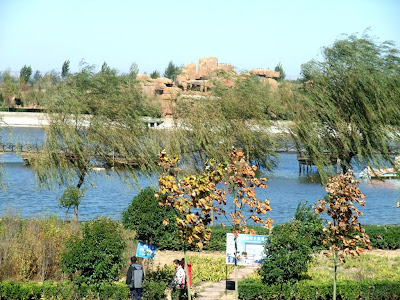
A huge sized oil painting of ancient Pujin Ferry placed at the new constructed site. The interesting part of the painting was that the pontoon in the picture was not at the same position when viewing from different angles. It moved with your sight.



Ancient wall remains from Ming Dynasty.


A replica of custom house built on Pujin Ferry ruin site.


Replica of the 8 iron ox displayed next to a man made pond.


A small version of Tang's Pontoon ?


Artifacts unearthed or discovered were housed at the little museum on the site. .




The ancient furniture, wooden carts and carriage.



Guanque Tower (鹳雀楼) lies on east bank of Yellow River in the ancient town of Puzhou at Yongji City, was first built in years from 557-580 by North Zhou Dynasty as a military watch tower during the era of South-North Dynasty. It was so called Guangue Lou as there were many storks stopped by and made their nests at the building. The Tower was burnt down during Yan Dynasty (1280-1341)and the original site was lost when Yellow River changed its course. To satisfy the many followers of Tang's Poet Wang-Huanzhi who composed a famous poem about Quanque Tower, West Gate Tower of Puzhou Town was taken as Guanque Tower after Ming Dynasty. In the reign of Emperor Jiajing (1522-1566) Yellow River once again re-route and the flood occurred brought great damage to West Gate Tower. The present Tang-styled Pavilion with height of about 74 meters, covering an area of 8222 sq meter, was started building in Feb 1997 and completed in August 2002.


Guanque Tower was famous for its delicate structure and was reputed as one of the 4 most famous ancient towers together with Yellow Crane Tower (黄鹤楼), Yueyang Pavilion (岳阳楼) and Tengwang Pavilion (滕王阁)。 Guanque Tower came into fame and became very attractive especially to many Chinese literates mainly due to the poem composed by the Tang Poet Wang-Huanzhi, about the scenery he had admired from Guanque Tower. He beautifully described in his poem about a day ends when the sun setting behind the hills, about the water of Yellow River that flowing into the ocean and he asked people to forward a step higher in order to see further. The two last phrases had become one of the most popular motivated lines to most Chinese educated people.


The Chinese language of the original poem composed in Tang Dynasty
白日依山尽,黄河入海流,欲从千里目,更上一层楼 - (王焕之)


The scenery of Yellow River though could not been seen as beautiful as described in the Tang's poem, it still looks great.



Guanque Tower stands on a superior location to capture the majestic view of Yellow River and surrounding mountains sight.



View from top floor of Quanque Tower.



The new Quanque Tower site includes various scenic spots to tourists beside the tower, like its landscape area, recreation areas, polo ground, lakes and square area and water park.



The landscape garden.


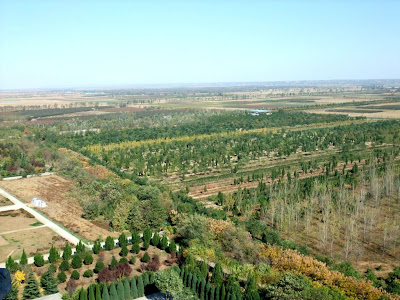



The tower model with its history and ancient calligraphy.



The pictures of the other 3 towers that shared the same fame with Quanque Tower in China. (1) Tengwang Pavilion (滕王阁) (2) Yueyang Pavilion (岳阳楼) and (3) Yellow Crane Tower (黄鹤楼)


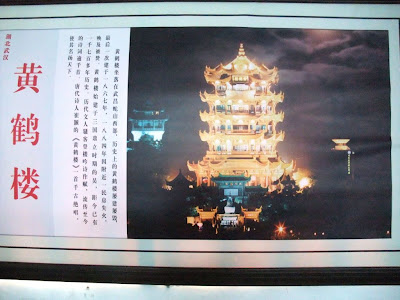
In one of the floors at Quanque Tower, there are series of Chinese ancient mythical legends presenting with illustrations and sculptures. Among all "Nvkua mended the sky" was the most interesting and well known Chinese myth. The legend was about Nvkua or Queen of Kua, a head of matriarchal society in primitive China, who was said to be the creator of human beings. She had a man's head with snake body. She molded human beings and creatures out of yellow soil, activated marriages making reproduction of life and lead them to fight against natural disasters. When there was once that the sky pillar was broken by the angry guy called Gongong, human beings were going to face great disaster with the collapse of north west sky, Nvkua produced and refined a kind of 5-colored soil to mend the hole at the sky and make the earth returning to its original and human continued its life circling till this day.


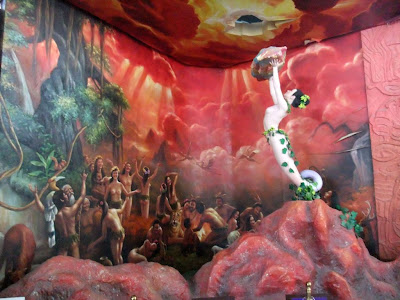
Fenglingdu situated at the border of Shanxi, Shaanxi and Henan, the three provinces of China, was once an important strategic ford in ancient China. It was about an hour drive from Yongji City. Since Ming and Qing Dynasty, customs house had been set here as a frontier pass for defense and traffic control purposes. Today, it is still a checking point for all long distance vehicles before leaving Shanxi Province. High in the sky of Fenglindu was the advertisement of an interesting local watch brand Guan-di-Biao named after the famous Three Kingdom worrier Guan-gong who was the hero of Shanxi people as he was borne here.




Crossing over the 1500 meter long Huanghe Bridge to witness the 65 degree turning point of Yellow River. The mother river of China flows all the way from north to south but blocked by one of the mountain range in Shanxi and forced to re-route into east direction towards Henan Province.


Yellow River flowing towards east.





The long distance bus from Yucheng to Xian has all safety concerns like safety hammer to all its passengers but not this extra one, who was given a little plastic stool and seated upright at the walk way for 3 1/2 hours journey.



The majestic view of Huashan along the way from Yucheng to Xian. Huashan is one of China's 5 sacred Taoist mountains and has a long history of religious significance. We included one day visiting Huashan in our itinerary but due to weather and complicated transportation, we finally decided to give up.
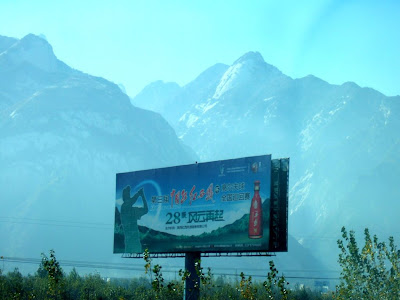



Would it possible to use one or two of your excellent pictures of the iron oxen of the Pujin bridge - with appropriate credit to you?
ReplyDelete